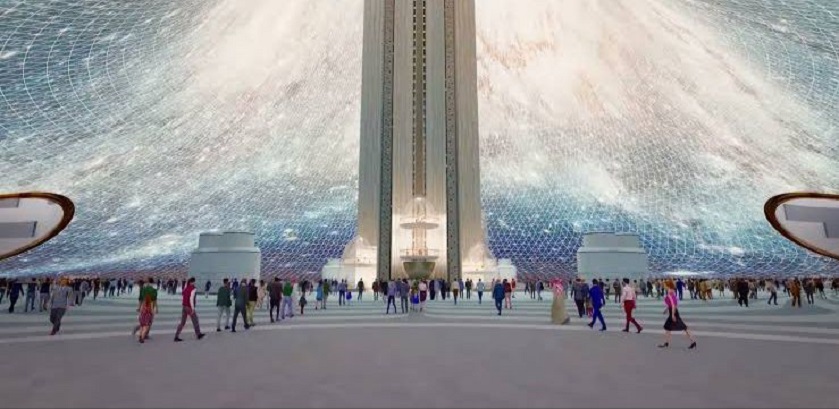
By Asad Mirza
SAUDI Arabia’s Crown Prince Mohammed bin Salman (MBS) announced the launch of the New Murabba Development Company, last week. The new company will oversee developing a new downtown area spread over 19 sq. km. in capital Riyadh
Authorities claim that plans have been created keeping sustainability and environment in mind. The project would include green spaces, walking and cycling pathways, to improve the quality of life by encouraging active, healthy lives and social interaction.
What is Mukaab?
The main feature of the project has been named The Mukaab, a gigantic cube structure has been described as the future ‘face of the city’, and critics say it may even be the face of a new Saudi Arabia, focussing and generating more revenue through tourism than petroleum. At present, the plan is to fill the cube with 100,000 residential units as well as 9,000 hotel rooms.
In addition, it will also have over 80 entertainment and cultural venues. A renowned museum, and a campus for a technology and design university. The 19 km space will accommodate thousands of people. The 25 million sq.mt. floor area is divided strategically into 104,000 residential units, 9,000 hotel rooms & 620,000 sq.mt. of leisure assets. Additional 980,000 sq.mts. will be covered by retail and 1.8 million sq.mt. will be dedicated to recreational facilities.
The building, will be 20 times bigger than the New York City’s Empire State Building, and will be a one-stop location for shoppers and business owners, with more than 980,000 square metres of retail shops and 1.4 million square metres of office space.
The Mukaab’s core structure will be an atrium, allowing for tons of natural light and foliage to thrive inside. The government brief promises an immersive ‘gateway into another world’ that is completely powered by the latest digital, virtual, and holographic technologies.
In recent years, Saudi Arabia’s abundance of oil money has sparked the design of some absolutely insane architectural projects. In 2021, MbS announced his $500 billion futuristic Neom city in the northwest of the country, with promises of robot maids, flying taxis, and a giant artificial moon. And last year, he unveiled a giant linear city, The Line, which aims to stretch over 106 miles and house 9 million people. The one-trillion-dollar project will essentially be its own massive city in the middle of a desert once it’s finished.
A New Kaabah?
Authorities claim that the project will add 180 billion riyals ($48 bn) to the Saudi economy and “create 334,000 direct and indirect jobs,” though the cost of the gargantuan project has not been mentioned.
New Murabba (square) and The Mukaab were widely ridiculed by social media users, both within and outside Saudi Arabia, apart from a large number of Muslims all across the globe, as soon as the plans were announced.
The Mukaab was also denounced for its likeness to the most important cube-like structure in Saudi Arabia and the most sacred structure of the Islamic world: the Kaabah. During Namaaz Muslims around the world face towards the structure in the centre of the Grand Mosque in Makkah, and circumambulate it during Hajj and Umrah pilgrimages.
Why this new developmental push?
Apparently, it seems, that Saudi Arabia has embarked on an ambitious project to diversify the economy away from oil and shed its image as a conservative, closed-off state. Besides promoting new narratives of development and progress.
Additionally, it has serious regional competition from neighbouring Dubai and the Qatari capital Doha, both of which have for decades tried to position themselves as regional tourism and investment hubs.
The kingdom already has an $800 billion plan to double the size of the capital in the next decade, as well as transform it into a cultural and economic hub for the region, according to Saudi media.
Over the years Saudi Arabia, which has seen an economic boom and a desert country transformed into a modern developing country was essentially based on the petroleum industry.
In addition it earns billions in revenues through the Umrah and Hajj pilgrimages. In recent years, it has made travel to the kingdom friendlier for the pilgrims and expansion plans in the two holy cities of Makkah and Madinah are underway to accommodate more number of tourists.
As a strategy it also is promoting the Umrah pilgrimage more than the annual Hajj, as the revenues through Umrah pilgrims flows throughout the year and the government is not forced to spend more on providing facilities and security to the Umrah pilgrims, whose stay is much shorter as compared to the Hajj pilgrims.
So far, the government was focussing more on promoting tourism, but with the ascension of MBS, it seems to have changed tracks. As his critics say he is pursuing a growth plan which seems more unIslamic than his parleys with the Israelis.
Views expressed in the article are the author’s own and do not necessarily represent the editorial stance of Kashmir Observer
- Asad Mirza is a political commentator based in New Delhi. He can be contacted at www.asadmirza.in
Follow this link to join our WhatsApp group: Join Now
Be Part of Quality Journalism |
Quality journalism takes a lot of time, money and hard work to produce and despite all the hardships we still do it. Our reporters and editors are working overtime in Kashmir and beyond to cover what you care about, break big stories, and expose injustices that can change lives. Today more people are reading Kashmir Observer than ever, but only a handful are paying while advertising revenues are falling fast. |
| ACT NOW |
| MONTHLY | Rs 100 | |
| YEARLY | Rs 1000 | |
| LIFETIME | Rs 10000 | |










